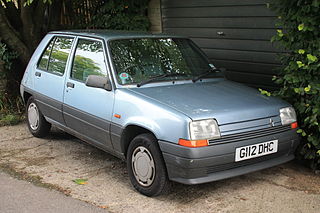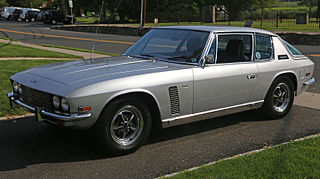
The Porsche 924 is a sports car produced by Porsche in Neckarsulm, Germany,from 1976 until 1988. A two-door, 2+2 coupé, the 924 replaced the 912E and 914 as the company's entry-level model.

The Toyota Celica is an automobile produced by Toyota from 1970 until 2006. The Celica name derives from the Latin word coelica meaning heavenly or celestial. In Japan, the Celica was exclusive to the Toyota Corolla Store dealer chain.

The Volkswagen Scirocco is a three-door, front-engine, front-wheel-drive, sport compact hatchback manufactured and marketed by Volkswagen in two generations from 1974 to 1992 and a third generation from 2008 until 2017. Production ended without a successor.

The Renault 5 is a five-passenger, three or five-door, front-engine, front-wheel drive hatchback supermini manufactured and marketed by the French automaker Renault over two generations: 1972–1985 and 1984–1996. The R5 was marketed in the US and Canada as Le Car, from 1976 until 1983. Renault marketed a four-door sedan variant, the Renault 7, manufactured from 1974 until 1984 in Spain by Renault's subsidiary FASA-Renault and exported to select markets.

The Hillman Avenger is a rear-wheel drive small family car originally manufactured by the former Rootes division of Chrysler Europe from 1970–1978, badged from 1976 onward as the Chrysler Avenger. Between 1979 and 1981 it was manufactured by PSA Peugeot Citroën and badged as the Talbot Avenger. The Avenger was marketed in North America as the Plymouth Cricket and was the first Plymouth to have a four-cylinder engine since the 1932 Plymouth Model PB was discontinued.

Jensen Motors Limited was a British manufacturer of sports cars and commercial vehicles in West Bromwich, England. Brothers Alan and Richard Jensen gave the new name, Jensen Motors Limited, to the commercial body and sports car body making business of W J Smith & Sons Limited in 1934. It ceased trading in 1976. Though trading resumed in 1998, Jensen Motors Limited was dissolved in 2011.

The Simca 1307 is a large family car produced by Chrysler Europe and subsequently PSA Peugeot Citröen from 1975 to 1986. Codenamed 'C6' in development, the car was styled in the United Kingdom by Roy Axe and his team at Whitley, and the car was engineered by Simca at Poissy in France.

The Chevrolet Vega is a subcompact automobile that was manufactured and marketed by GM's Chevrolet subdivision from 1970 to 1977. Available in two-door hatchback, notchback, wagon, and sedan delivery body styles, all models were powered by an inline four-cylinder engine with a lightweight, aluminum alloy cylinder block. The Vega first went on sale in Chevrolet dealerships on September 10, 1970. Variants included the Cosworth Vega, a short-lived limited-production performance model, introduced in the spring of 1975.

The Chevrolet Monza is a subcompact automobile produced by Chevrolet for the 1975 through 1980 model years. The Monza is based on the Chevrolet Vega, sharing its wheelbase, width, and standard inline-four engine. The car was designed to accommodate the GM-Wankel rotary engine, but due to mediocre fuel economy and emissions-compliance issues the engine was cancelled, and a V8 engine option was substituted. The Monza name has also been used for several other cars.

The Jensen Interceptor is a grand touring car which was hand-built at the Kelvin Way Factory in West Bromwich, near Birmingham in England, by Jensen Motors between 1966 and 1976. The Interceptor name had been used previously by Jensen for the Jensen Interceptor made between 1950 and 1957 at the Carters Green factory. Jensen had extensively used glass-reinforced plastic for the fabrication of body panels in the preceding two decades, but the new Interceptor saw a return to a steel body-shell. The body was designed by an outside firm, Carrozzeria Touring of Italy, rather than the in-house staff. The early bodies were built in Italy by Vignale, before Jensen took production in house, making some subtle body modifications.

The Dino 308 GT4 and 208 GT4 were mid-engined V8 2+2 cars built by Ferrari. The Dino 308 GT4 was introduced in 1973 and supplemented by the 208 GT4 in 1975. The cars were sold with Dino badging until May 1976, when they received Ferrari badging. The GT4 was replaced by the Mondial 8 in 1980 after a production run of 2,826 308s and 840 208s.

The MGB is a two-door sports car manufactured and marketed from 1962 until 1980 by the British Motor Corporation (BMC), later the Austin-Morris division of British Leyland, as a four-cylinder, soft-top sports car. It was announced and its details first published on 19 September 1962. Variants include the MGB GT three-door 2+2 coupé (1965–1980), the six-cylinder sports car and coupé MGC (1967–69), and the eight-cylinder 2+2 coupé, the MGB GT V8 (1973–76).

The Jensen-Healey is a British two-seater convertible sports car, produced by Jensen Motors Ltd. in West Bromwich, England from 1972 until 1976.

The Opel Manta is a rear-wheel-drive sports coupé built by German manufacturer Opel in two generations from 1970 to 1988. The Manta was a mildly sporting coupé based on the Ascona family car, akin to the Ford Falcon-based Mustang and its various imitators such as the Ford Capri. The Manta remained rear-wheel drive for both generations and also saw certain competition success. Its name comes from the Manta ray.

The Jensen 541R is a closed four-seater GT-class car built in the United Kingdom by Jensen between 1957 and 1960.
The 1975 World Sportscar Championship season was the 23rd season of FIA World Sportscar Championship motor racing. It featured the 1975 World Championship for Makes which was open to Group 5 Sports Cars and Group 4 Special GT Cars. It also included the FIA Cup for GT Cars and the FIA Cup for 2-Litre Cars. The three titles were contested concurrently over a nine race series which ran from 1 February to 12 July 1975.

The Jensen 541S was Jensen Motors luxury GT model of the Jensen 541. Announced in mid-October 1960, the Jensen 541S was four inches wider than the 541R. The increased track allowed the new car's interior to be roomier and improved the roadholding. The 541S had a conventional radiator grill to allow for the extra heat given by a proposed new V8 engine, and a Salisbury limited slip differential for the extra torque demanded..
Kjell Qvale was a Norwegian-American business executive. Qvale was one of the key figures in the creation of the Jensen-Healey. Qvale became the first distributor for Jaguar on the Pacific West Coast. Qvale was one of the founders of the San Francisco Auto Show and the Pebble Beach Concours d'Elegance. He was credited with the concept of the Corkscrew signature corner of Laguna Seca.

John Fitzpatrick is a British former racing driver, winning many titles throughout his career. He works within motorsport as a consultant doing corporate events and driver management. He published a book "Fitz-My Life at the Wheel" in 2016.
The Jensen H-type is a saloon car built by Jensen Motors from 1938 until 1945. The car was built on a strengthened Ford chassis and used aluminum for the body panels. The car was sold with a 4,279 cc OHV straight-eight engine built by Nash. However, there was at least 1 H-type that was fitted with a V12 from the Lincoln Zephyr.



















